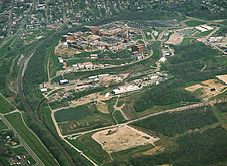- Mound Laboratories
-
Mound Laboratories 
Aerial view of Mound LaboratoriesBuilt 1948 Location Miamisburg, Ohio Coordinate 39°37′45″N 84°17′11″W / 39.629094°N -84.286315°ECoordinates: 39°37′45″N 84°17′11″W / 39.629094°N -84.286315°E Mound Laboratories in Miamisburg, Ohio was an Atomic Energy Commission (later Department of Energy) facility for Nuclear weapon research during the Cold War.
The laboratory grew out of the World War II era Dayton Project (a site within the Manhattan Project) where the neutron generating triggers for the first plutonium bombs were developed.
Post-war construction of a permanent site for Dayton Project activities began in 1947. The lab was originally known as the Dayton Engineer Works. The lab began operations in 1948 and was managed by Monsanto. Mound produced detonators, cable assemblies, timers, firing sets, and other equipment. In 1954 Mound began working with Tritium. The lab disassembled bomb components, recovering the Tritium within and sending it for repurification at Savannah River Site. Mound supplied enriched non-radioactive isotopes. The lab also produced plutonium-238-powered thermoelectric heat sources called SNAP or Systems for Nuclear Auxiliary Power for the U.S. space program.
For security, several of the large buildings on site were built seven stories underground and were visible only as small elevator rooms on the surface. This design was so that they could sustain any conventional bombing attack.
Mound was declared a Superfund site and was put on the National Priorities list in 1989. In[clarification needed] a decision was made to close the plant by 2006. Clean-up of the site began in 1995. Work with Tritium ended in 1997. The final closure date has been pushed back to at least 2010.
Sources
Categories:- Buildings and structures in Montgomery County, Ohio
- United States Department of Energy facilities
- Superfund sites
- Nuclear weapons infrastructure of the United States
Wikimedia Foundation. 2010.
